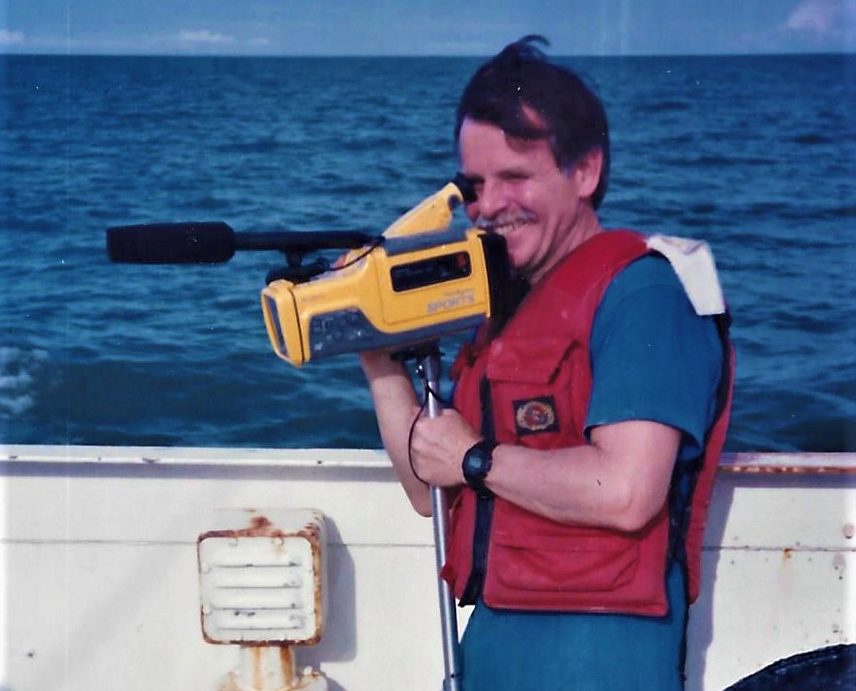Article begins
The 2019 Edward Sapir Book Prize was awarded to Co-Operative Action, by Charles (Chuck) Goodwin. The Sapir Prize recognizes a book that makes the most significant contribution to our understanding of language in society, or the ways in which language mediates historical or contemporary sociocultural processes. The celebration of this award at the 2019 AAA Annual Meeting in Vancouver was bittersweet, since Goodwin passed away shortly after the official release of the book in 2018. But the self-effacing joy he took in sharing ideas with a community was evident in a video shown by his wife Marjorie (Candy) Goodwin, who accepted the prize on his behalf.

Image description: A photograph of a man standing aboard an oceanographic research vessel. He is looking through a video camera, wearing a life preserver vest, and smiling. Beyond the ship, a large expanse of water can be seen extending to the horizon.
Caption: Chuck Goodwin doing fieldwork in 1990 aboard an oceanographic research vessel at the mouth of the Amazon River. Heather Astwood
The Sapir Prize committee had the pleasure of reading many very fine books, given that the award returned to a biennial competition in this round. We were encouraged by trends we saw toward a broad vision of the field, the creative application of its tools to diverse semiotic materials and pressing social issues, and engagingly accessible styles of writing. Goodwin’s Co-Operative Action exemplifies all of these, but this magnum opus stands in a class by itself. It gives us the rarest combination of big theory with the hands-on, granular analysis of a wealth of empirical data.
The unexpected hyphen in the book’s title signals a vision of co-operation that is not limited to the usual sense of cooperation, that is, collaboration for mutual benefit. That hyphen turns co-operate into a transitive verb. Participants in social life operate the tools of cognition, communication, and action, but they don’t do so on their own. They co-operate that machinery, performing operations on the materials others have operated on. We “inhabit each other’s actions,” as Goodwin puts it (1). This may be axiomatic in our field, but rarely has it been so convincingly demonstrated as in this book. Across activities ranging from children’s play to archaeological digs to scientific lab work to court proceedings, Goodwin shows us how co-operative action takes place simultaneously through different communicative modalities as well as sequentially in the nanoseconds of conversation and in the longue durée of generations. He argues that culture is sedimented across time out of new social and cognitive actions that decompose, transform, and reuse the resources made available by the earlier actions of others (1)—and, as the Sapir Prize committee noted, by one’s own earlier actions.
This co-operative mode is the distinctive feature of humanness
In this magisterial work, we meet again with many familiar figures from Goodwin’s decades of published research, much of it in collaboration with Candy Goodwin. There is Sergeant Duke from the so-called Rodney King case, the argumentative hopscotcher Carla and the hapless chiriona she accuses of cheating, the archaeology students with their Munsell color charts trying to diagnose dirt, and the much-loved, aphasiac Chil and his supportive co-conversationalists Chuck and Candy. But there are cast members we hadn’t seen before as well, such as geochemists in their lab. This is not just a compilation of greatest hits. The book is a rich illustration of its own thesis, a transformative reworking and integration of old and new that yields pathbreaking insight.
Goodwin’s overarching argument is that the intrinsically co-operative character of human action is what “sits at the center of human adaptation,” in his metaphorical mantra (239). Co-operative action allows for the unique accumulative yet flexible power of human culture, which is “progressively shaped by a consequential past while remaining both contingent and open-ended,” as Goodwin puts it (3). Primatologists, ethologists, and other anthropologists may or may not agree that this co-operative mode is the distinctive feature of humanness, as Goodwin proposes. Nonetheless, the professional vision he develops should provoke intra- and inter-disciplinary engagement and open up new intellectual directions for our field, the field of anthropology as a whole, and linguistic anthropology in particular. To quote from the book’s concluding call for a “‘radical’ turn in anthropology,” that is, a return to its roots:
The original vision of anthropology was the study of all aspects of what it is to be human—language, diverse forms of social organization, tools, biology, our ties to other animals, etc.—from a framework able to encompass all these phenomena, and investigate their mutual relationships…. Study of the many manifestations of co-operative action explores the possibility of recovering…the integrated vision of human capacities in their full linguistic, social, material, biological, cognitive, and historical intertwining, which sits at the root of anthropology’s original, radical vision of what it is to be human (477–78).
Kathryn Woolard is professor emerita of anthropology at the University of California, San Diego and former president of the Society for Linguistic Anthropology. Her most recent book, Singular and Plural: Ideologies of Linguistic Authority in 21st Century Catalonia, was awarded the Sapir Book Prize in 2017.
Thea Strand is a contributing editor for the Society for Linguistic Anthropology’s section news column.
Cite as: Woolard, Kathryn. 2020. “2019 Sapir Book Prize Awarded to Charles Goodwin’s Co-Operative Action.” Anthropology News website, April 30, 2020. DOI: 10.1111/AN.1398

